Healthy Budget Meal Prep
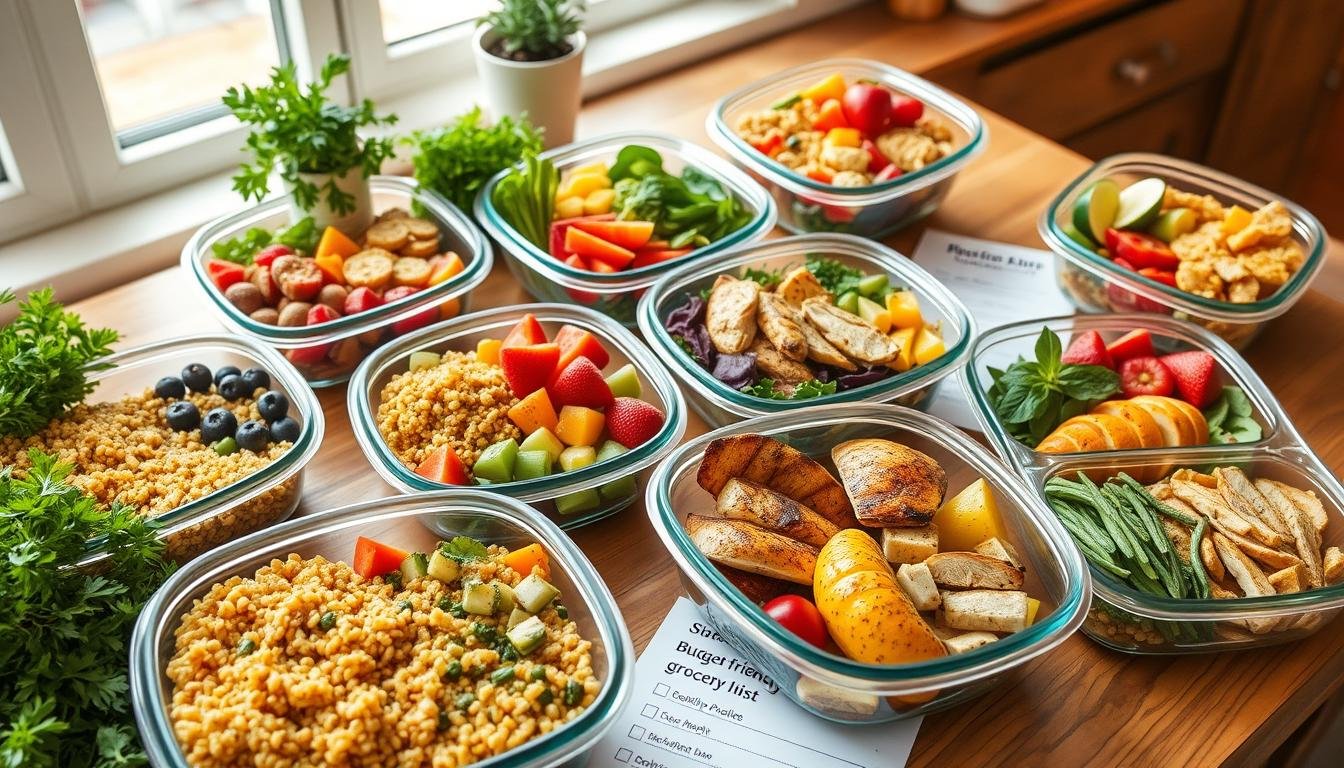
Are you tired of spending too much just to eat healthy?
Find out how to prepare healthy meals on a budget. It’s surprising, but true. You don’t need to spend a lot to eat well. With just 11 key ingredients, you can make tasty meals. Each meal costs less than $3.00!
Enjoy delicious breakfasts and dinners without spending much. Start with a $2.17 breakfast crepe, including gluten-free crepes, fresh fruits, and rich yogurt. Then, have a $2.09 stuffed sweet potato for lunch.
This budget meal prep guide is perfect even if you’re short on time or space. It’s all about smart shopping and using what’s in season. Find out how college students save by shopping smart and choosing cheaper, healthy ingredients.
Learn how meal prep on a budget can be good for your diet and wallet. We offer tasty recipes and show their low costs. Are you ready to eat better without breaking the bank?
Understanding the Benefits of Meal Prep
Meal prep is a great way to change how you cook and eat. It makes your daily routine easier. It also helps you eat healthier and waste less food.
Save Time and Stress
About 31% of adults say not having enough time stops them from cooking more.
By cooking all at once, you visit the store less. This cuts down on stress from figuring out dinner every day.
Promote Healthier Eating Habits
Meal prep lets you eat more nutritious food. This supports healthy eating. You end up eating better food and less food overall.
Cooking at home means a lower risk of diseases like type 2 diabetes. Adding things like “Meatless Monday” and lots of veggies improves your diet. You get important vitamins, minerals, and fibers.
Reduce Food Waste
Meal prep helps you waste less food. You use every ingredient well. This stops food from going bad in your kitchen.
Research says about 40% of food in the U.S. is wasted every year. Meal prep helps tackle this problem. Planning meals well means your food stays fresh longer and you waste less.
“Meal prep can reduce grocery store trips, saving consumers time and reducing the hours spent planning meals.” — Statistical Report
Meal prep lets you control your diet and reduce waste. It makes meal planning less stressful. This method is simple but can really improve how you eat and live.
| Benefits | Details |
|---|---|
| Save Time | Consolidate cooking into one session, reducing daily prep and cleanup time. |
| Promote Healthy Eating | Focus on nutritious ingredients, facilitating a balanced diet. |
| Reduce Food Waste | Efficient use of ingredients prevents spoilage and saves money. |
| Economic Savings | Lower average weekly food costs by avoiding impulsive and expensive takeout. |
Essential Tools for Meal Prep
Finding the best tools for cooking can change how you make meals. It makes cooking faster and more fun. You have many options for tools and gadgets to help you.
Must-Have Kitchen Equipment
It’s important to have the right tools for cooking. An Instant Pot makes cooking rice and soups faster. You won’t need extra pots. The Ninja Kitchen System helps you make smoothies and sauces. It makes your kitchen more versatile. An immersion blender lets you blend soups without a mess. And don’t forget a full set of measuring tools to save time.

Time-Saving Gadgets
There are gadgets that save you time in the kitchen. A \*chopper tool\* is great for cutting veggies and making salads. An \*herb stripper\* makes it easier to handle greens. A \*rotary grater\* shreds cheese quickly. An \*adjustable measuring cup\* measures both dry and wet ingredients. It also saves space. \*Battery-operated can openers\* and \*garlic twisters\* make prep work faster.
Food Storage Solutions
How you store food is important for keeping it fresh. Glass containers are better because they last longer than plastic. A \*vacuum sealer\* helps you buy in bulk and save meals for later. To keep avocados fresh, use an \*avocado keeper\*. \*Shaker bottles\* are great for taking drinks with you.
| Tool | Function | Key Benefit |
|---|---|---|
| Instant Pot | Accelerates cooking times | Multitasking without extra dishes |
| Ninja Kitchen System | Makes smoothies and sauces | Versatility |
| Immersion Blender | Purees soups directly in the pot | Reduces cleaning time |
| Chopper Tool | Dices vegetables | Streamlines salad preparation |
| Glass Containers | Stores prepared meals | Durability |
| Vacuum Sealer | Bulk purchases and portioning | Saves money |
Planning Your Healthy Meal Prep
Start with good planning and picking nutritious food. Planning your meals helps you save time and eat better. It also cuts down on wasted food.

Choosing Nutritious Ingredients
Picking healthy foods is key. Go for fresh fruits, veggies, lean meats, and whole grains. Colorful fruits and veggies make your meals more nutritious.
Meal prepping is great for saving money and time. It lets you control what you eat, helping with weight and nutrition.
Creating a Balanced Menu
Plan meals with protein, complex carbs, and fats. Like a plate with chicken, quinoa, and broccoli. This mix meets your nutrition needs and tastes great.
Weekly Recipe Inspiration
It’s important to find recipes that match your time and tastes. Here’s a table for quick, healthy meals:
| Recipe | Prep Time | Servings | Storage |
|---|---|---|---|
| Southwest Black-Bean Pasta Salad Bowls | 30 mins | 4 | Refrigerate for 4 days |
| Creamy Chicken Noodle Soup | 20 mins | 6 | Refrigerate for 3 days |
| Power-Packed Burritos | 30 mins | 4 | Freeze for 6 months |
| Strawberry-Banana Smoothie Packs | 10 mins | 6 | Freeze for 3 months |
Using these recipes makes meal prep fun. You’ll save time and money. And you’ll keep eating healthy a part of your life.
Budget-Friendly Shopping Tips
Food prices keep going up, making grocery shopping stressful. But being on a budget doesn’t mean you have to give up good food. You can still eat well without spending too much. This means buying smart and finding ways to save money.
Seasonal Produce Buying Guide
Buying fruits and veggies that are in season can save money. Plus, they taste better and are fresh. They cost less than those not in season. Vegetables picked during their season can be 30% cheaper. You get to save and eat better.
Farmers’ markets and CSA programs are great for affordable, fresh produce. They offer good deals on the freshest items.

Cost-Saving Brands and Alternatives
Choosing cheaper brands can cut your grocery bill. Store brands are often as good as famous ones but cost less. This lets you save more. Brands like ‘365 Organic’ at Whole Foods are good for your wallet.
Buying in bulk is another smart way to save. Items like quinoa, brown rice, and oats are cheaper this way. You can reduce the cost per unit by 20-50%. For example:
| Item | Average Cost Per Pound | Saving Margin When Bought in Bulk |
|---|---|---|
| Quinoa | $1.50 | 30% |
| Brown Rice | $1.00 | 20% |
| Oats | $0.80 | 25% |
Using Coupons and Discounts
Using coupons and discounts is smart. Shops like Costco have discount cards that save money over time. Check store flyers and use apps to find coupons. This can lower your costs a lot.
Try online shopping carts to plan your spending. It helps you see how much you’ll spend before you buy. This way, you shop smarter. If you keep this up, you’ll make the most of your grocery budget. You’ll eat well and keep your finances healthy too.
Easy and Healthy Meal Prep Recipes
Adding healthy meal prep recipes to your life can change things up. It helps you eat well and save money. With tasty breakfast, lunch, and dinner ideas, meal prep is great. You can make meals ahead to eat right and save time. Here are some top meal prep tips.
Breakfast Ideas on a Budget
Prepping breakfast can be cheap and healthy. Here are some ideas that are good for you:
- Oatmeal Breakfast Cookies: Keep well at room temperature for a few days or freeze for up to 3 months. Ideal for on-the-go mornings.
- Breakfast Egg Muffins: These can be prepared in advance and stored in the fridge for up to 3 days, offering a protein-packed start to your day.
- Healthy Banana Bread: Stays fresh at room temperature for up to 4 days and can be frozen afterwards. A delightful and healthy start to any morning.
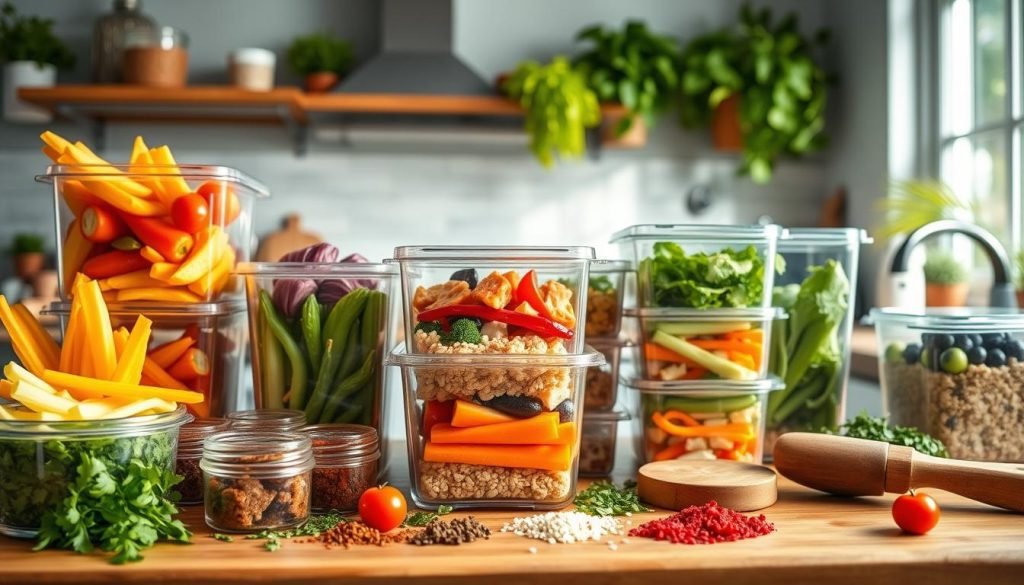
Lunch Recipes for the Week
Lunches you prep can give you something to look forward to. These recipes are easy and stay fresh:
- Black Bean and Corn Salad: This salad gets better over time in the fridge, perfect for planning ahead.
- Greek Salad Cottage Cheese Bowls: High in protein and well-balanced, great for those needing more protein.
- Onigirazu (Sushi Sandwich): These let you enjoy meals from around the world, prepared early for a special lunch.
Dinner Options to Savor
Prepping dinners saves time and lets you end the day with good food:
- Slow-Cooker Korean Beef: This meal is affordable and tasty, perfect for those on a budget.
- Curry Lentil Soup: It lasts up to 4 days in the fridge. You can make more and freeze some.
- Low-Carb Turkey Gyro Bowls: These are great for watching carbs, and they taste great too.
Using these simple and healthy meal prep recipes can help you eat better, save time, and lower stress at meal times. Having lots of breakfast, lunch, and dinner choices makes every meal good and healthy.
| Recipes | Storage Duration |
|---|---|
| Oatmeal Breakfast Cookies | 3 Days (Room Temperature), 3 Months (Freezer) |
| Black Bean and Corn Salad | 5 Days (Fridge) |
| Slow-Cooker Korean Beef | 1 Month (Freezer) |
| Greek Salad Cottage Cheese Bowls | 3 Days (Fridge) |
| Low-Carb Turkey Gyro Bowls | 4 Days (Fridge) |
Incorporating Protein into Your Meals
Adding protein to your meals helps keep a balanced diet. It makes you feel full and stops you from eating too much. Let’s look at cheap protein sources and different ways to cook them. This makes your meals rich in nutrients.
Affordable Protein Sources
Your meal prep can be cheap. Some affordable protein sources are canned tuna, eggs, and chickpeas. These items are cheap but full of nutrients. For example, a half-cup of chickpeas has about 7 grams of protein. Three ounces of salmon have 22 grams of protein. A quarter-cup of almonds offers 7 grams of protein, too.
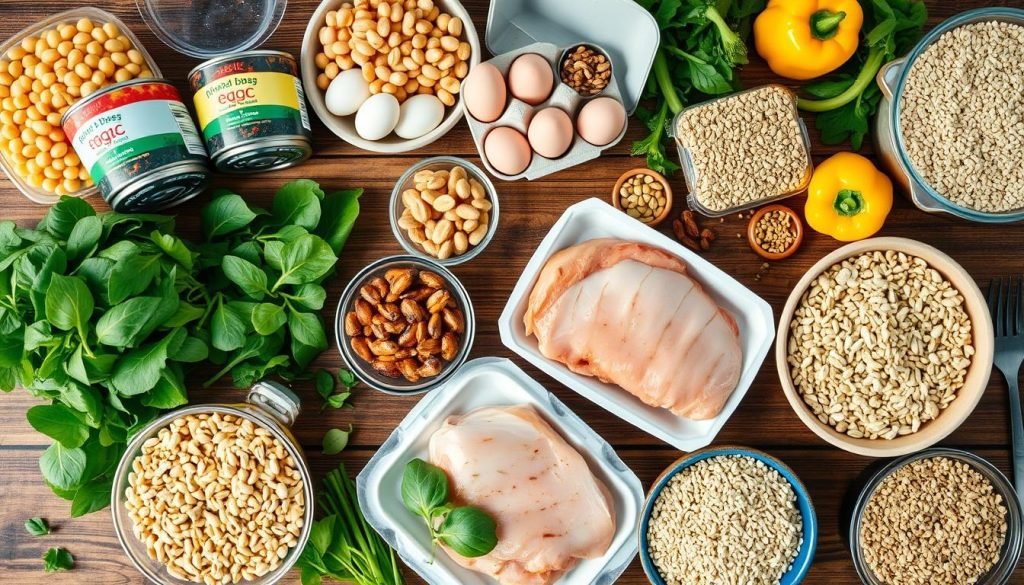
Cooking Methods for Protein
Different protein cooking methods make your food taste better and healthier. For chicken, try grilling, baking, or poaching. About 70% of people cooking at home do this. Fish can be grilled, broiled, or pan-seared. 55% of people like grilling fish. For tofu, try marinating then baking or sautéing it.
Beans and lentils are great in many recipes. Using beans instead of some meat can cut protein costs by 30%.
Meal Prep-Friendly Protein Recipes
Here are some meal prep recipes with lots of protein:
- Grilled Chicken or Tofu Skewers: Adding veggies cuts calories by 15% versus meat-only. You get about 25 grams of protein.
- Baked Fish with Herb Crust: If you eat it with whole grains, you get about 30 grams of protein.
- Tofu Stir-Fry with Seasonal Vegetables: This meal has about 20 grams of protein. It’s very nutritious.
- Grilled Shrimp in Foil Packets: With veggies, this dish has around 24 grams of protein per serving.
- Bean Salad: Choosing low-sodium canned beans gives you up to 15 grams of protein. It’s great as a side dish.
Using these protein sources and recipes in your meal prep helps you eat enough protein. And it’s both cheap and tasty.
Maximizing Your Meal Prep Efficiency
Getting better at meal prep can save you a lot of time each week. It can also make you feel less stressed. Let’s talk about some good ways to make meal prep easier and faster.
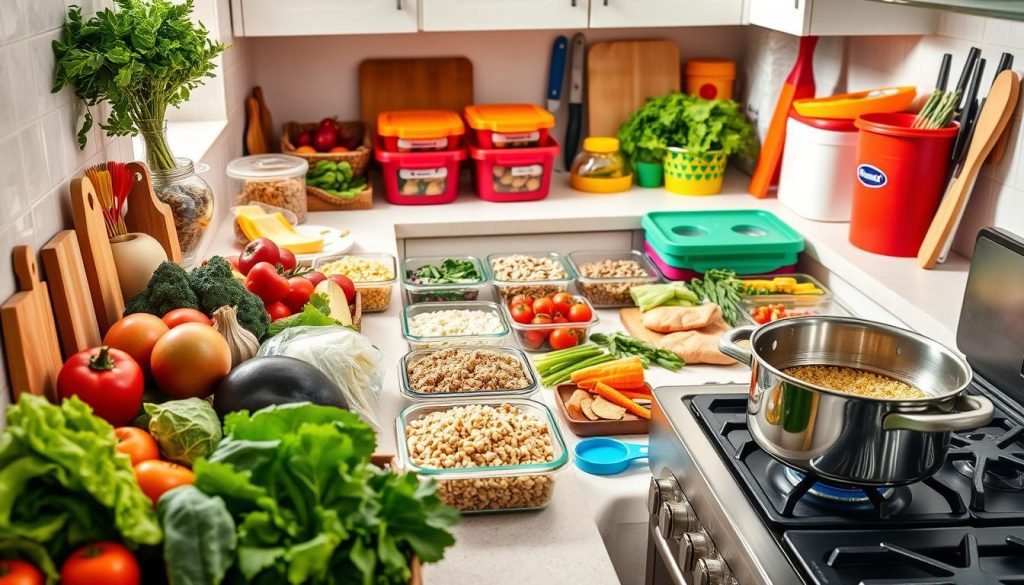
Batch Cooking Techniques
Batch cooking is a big help in meal prep. It saves you time and work. You can cook lots of meals at once, using the same ingredients for different meals. For example, you can use quinoa for breakfast, lunch, and dinner.
Batch cooking saves you up to 5 hours a week. Try to make recipes that need only five main ingredients. This simple way still gives you different tasty and healthy meals.
Freezing and Reheating Tips
Freezing meals keeps their taste and goodness. Meals can stay fresh for 3-4 days in the fridge. They last up to 3 months in the freezer. Use good containers like glass bento boxes and mason jars to avoid messes and food getting bad.
Labeling food helps you know how fresh it is. This lowers food waste by 30%. When you warm up food, make sure it stays moist. You can microwave with a wet paper towel or use the oven. This makes it taste just cooked.
Organizing Your Prep Schedule
A good meal prep plan makes things easier. Start by making one big meal first. This helps you get used to prepping without too much trouble. Set times for shopping and cooking. This stops you from buying things you don’t need and wasting time. Incorporating meal prep essentials for beginners can further streamline your process. Invest in quality containers to store your meals, ensuring they are microwave-safe and portion-controlled. Additionally, experiment with simple recipes that can be easily scaled up, allowing you to build a variety of meals without extra effort.
Studies show making a shopping list can save you 20% on groceries. Get your kitchen ready before you start. This can make you 40% more efficient. Cook different parts of your meals at the same time. This can cut your cooking time in half each week. Then you have time for other things.
| Strategy | Time Saved | Additional Benefits |
|---|---|---|
| Batch Cooking | Up to 5 hours/week | Streamlined ingredient use |
| Freezing Techniques | Up to 3 months meal storage | Preserved taste and nutrition |
| Organized Workspace | Up to 40% efficiency increase | Reduced preparation time |
Using these methods can really help your efficient meal prep plan. You’ll always have great home-cooked meals ready. And you won’t have to cook every single day.
Making the Most of Leftovers
Handling leftovers well lets you save money and cut down on waste. Every year, an average American home throws away $1,600 of food. By getting creative and storing food correctly, you waste less. This saves you money and boosts your cooking skills.
Creative Ways to Use Leftovers
Try mixing different foods to make new, tasty dishes. Leftovers mean you don’t need to buy more. Turn rice into fried rice, mix roasted veggies with pasta, or add chicken to salads or sandwiches. A weekly “leftover buffet” can also prevent food from spoiling.
Store-Bought vs. Homemade
Homemade meals are usually healthier than store-bought ones. They let you control what goes into your food and how much you make. Using an app to plan meals helps you shop and cook more efficiently. Even though store-bought meals are convenient, cooking at home has many benefits.
Leftover Storage Strategies
Storing leftovers properly keeps them fresh and safe. Use small, airtight containers for freezing. Follow a “first in, first out” rule so you use older food first. Putting items that will spoil soon at the front of your fridge helps reduce waste. Here are tips:
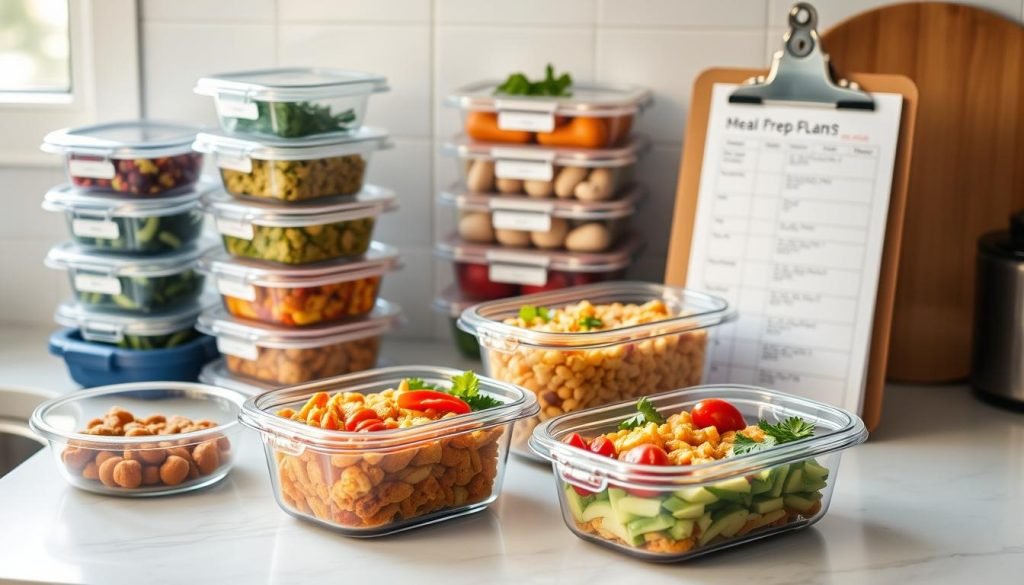
| Storage Method | Benefits |
|---|---|
| Small Airtight Containers | Preserves freshness, prevents freezer burn |
| Labeling with Dates | Helps track expiration and reduces waste |
| First In, First Out Principle | Ensures older items are used first |
| Meal Planning Apps | Enhances organization and tracks leftovers |
| Weekly Inventory Checks | Prevents overbuying and identifies what needs to be used |
Following these tips can help you manage your food better and waste less. Whether it’s choosing homemade over store-bought or finding new uses for leftovers, these ideas make your kitchen more budget-friendly and efficient.
Healthy Snacks for Meal Prep
Planning snacks ahead is great for your health and productivity. Healthy snacks for meal prep help you have good, energy-boosting foods ready. We’ll talk about simple snack ideas, snack size control, and how to keep snacks fresh.
Quick and Easy Snack Ideas
Pick snacks that are easy and full of good stuff. Try these:
- Hard-boiled eggs: Sprinkle with your favorite seasonings for a protein boost.
- Homemade granola bars: Flavor them with s’mores, tropical, or peanut butter chocolate chip.
- Tuna protein box: Combine tuna salad, cheese, and hard-boiled eggs for a filling snack.
- Carrots and hummus: A great way to add more veggies to your diet while enjoying a tasty dip.
- 4-ingredient protein chia pudding: A high-protein option that’s easy to make.

Portion Control for Snacking
Portion control helps avoid overeating. Plan your snacks with the right size in mind. By planning, people eat 20% less junk food. Here’s how:
- Use small containers: Pre-portion snacks into mason jars or bento boxes.
- Read labels: Pay attention to serving sizes when purchasing ingredients.
- Healthy options: Choose whole foods like fruits, nuts, and veggies for more energy.
Snack Storage Recommendations
Storing snacks properly keeps them fresh longer. Here are the best methods:
- Mason jars: Perfect for dry snacks like nuts and seeds.
- Glass meal prep containers: Ideal for prepped veggies and protein-rich options like hummus with peppers.
- Airtight containers: Ensure freshness for up to five days, making meal prep easy.
Meal prepping snacks saves up to 60% compared to store-bought. Choose options like popcorn, energy balls, or kale chips. These snacks will keep you full and energized all day.
Adapting Meal Prep for Dietary Needs
Changing your meal prep for dietary needs makes meals enjoyable for everyone. This works whether you want vegetarian, gluten-free, or low-carb meals. Making these changes is easy and helpful.
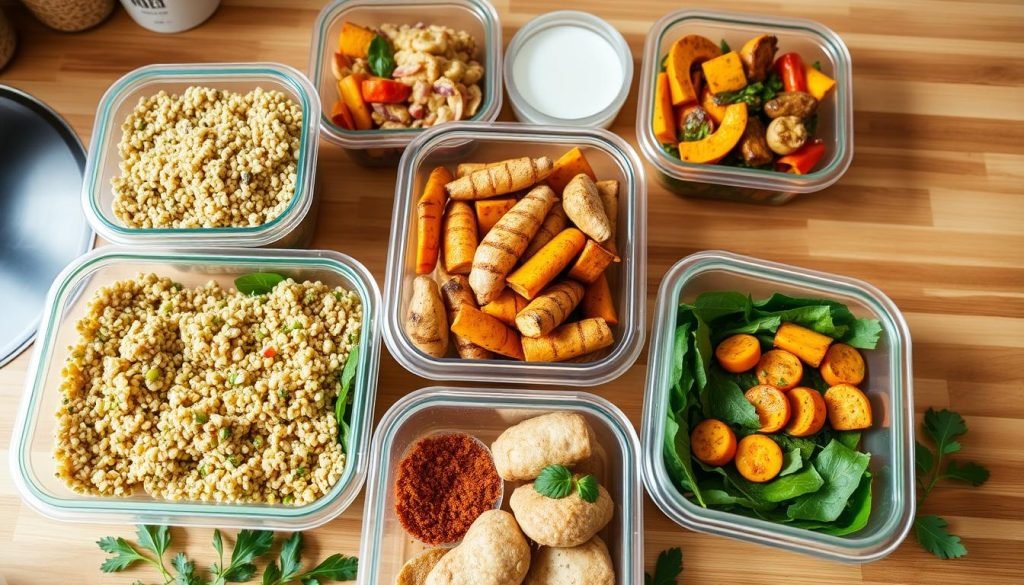
Vegetarian and Vegan Options
For vegetarian meal prep, use different plant proteins like lentils, chickpeas, and tofu. The Cleveland Clinic suggests preparing ingredients ahead. This means washing, cutting, and peeling veggies in large amounts to cut down on cooking time. Try having Meatless Mondays to make meals more interesting.
Gluten-Free Prepping Strategies
Making gluten-free meals is easy with good planning. Focus on foods that are naturally free of gluten like quinoa, rice, and potatoes. When plating, fill half with various veggies, a quarter with protein, and a quarter with whole grains. This keeps meals balanced. Always be careful about cross-contamination, especially when sharing your kitchen.
Low-Carb Meal Ideas
For low-carb diets, cooking in batches and prepping ingredients ahead are key. Make sure your meals match your daily calorie needs. Choose foods rich in protein and healthy fats, and keep carbs low. Freezer meals are a great way to have a low-carb option ready anytime.
| Meal Prepping Methods | Benefits |
|---|---|
| Individual Portions | Quick reheating, caters to busy schedules |
| Batch Cooking | Preparation of large dishes, time-saving |
| Ingredient Prepping | Reduces daily cooking time by prepping vegetables |
| Freezer Meals | Long-term storage, reduced food waste |
Staying Motivated with Meal Prep
Maintaining excitement for meal prepping can be tough, but starts with achievable goals.
If you’re new or experienced, setting realistic meal prep goals that fit your life is key.
Setting Realistic Goals
Begin by setting realistic meal prep goals that you can stick to each week. It’s about getting better, not being perfect. BJ Fogg, a habit expert, says one small step weekly makes a big difference. By marking meal prep times on your calendar, you’re way more likely to do it. Spending 1-2 hours on meal prep each week, as Prep Dish’s Allison Schaaf suggests, keeps it doable and ongoing.
Tracking Your Progress
Keeping track of your progress helps keep you motivated. Log your recipes, meal plans, and even what’s in your freezer. This way, you can see how you’re doing. Many people find they save up to 3 hours a week by meal prepping. They also eat 25% more healthy meals. Use apps or a journal to watch your progress and celebrate the small wins along the way.
Connecting with Meal Prep Communities
Joining a meal prep community gives you the support and push you need. Join places like Prep Dish’s Facebook group to exchange tips and stories. These groups are great for finding new ideas, overcoming obstacles, and meeting others with the same goals. Being in a meal prep community keeps you dedicated and turns meal prepping into a fun, social event.